|
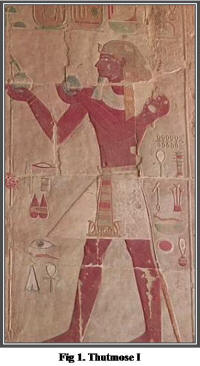 According
to Exodus 7:7
Moses was 80 years old when he spoke to Pharaoh. Adding
80 years to the date of the Exodus, 1446 BC, equals 1526
BC, the approximate year in which Moses was born. According
to Exodus 7:7
Moses was 80 years old when he spoke to Pharaoh. Adding
80 years to the date of the Exodus, 1446 BC, equals 1526
BC, the approximate year in which Moses was born.
-
The ruler of
Egypt at this time was
Pharaoh Thutmose I, 1539-1514 BC, (fig. 1). If you
remove THUT from his name you are left with
MOSE.
-
The name “Moses” finds meaning
both in Hebrew and Egyptian. In Hebrew mosheh
means “drawn out” and in Egyptian mos means
“child,” it being the same element as found in Thutmose,
which means “child of Thoth.”
1. Early Home
Thutmose I’s order that all male
children of the Hebrews be thrown in the Nile to drown
(Exod. 1:22), did not
keep one very important person from entering Israelite
history, Moses.
-
Moses’ father, Amram, and his
mother, Jochebed, were both descendants of Levi
(Exod.
6:16-20). They already
had two children: Aaron, three years old, and Miriam,
about seven. Jochebed hid him
in a basket in the reeds along the bank of the Nile.
While Pharaoh’s daughter was bathing she found him and
raised him as her son.
-
Although the
Bible never records her name, the Jewish historian
Josephus writing in the first century does. He states:
“Pharaoh’s daughter, Thermuthis, was walking along the
river bank. Seeing a basket floating by, she called to
her swimmers to retrieve it for her. When her servants
came back with the basket, she was overjoyed to see the
beautiful little infant inside . . . Thermuthis gave him
the name Moses, which in Egyptian means saved from the
water. . . Having no children of her own, she adopted
him as her son.”
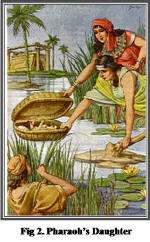 -
Josephus
says the daughter of pharaoh was Thermuthis (fig. 2),
very similar to the royal name Thutmose. -
Josephus
says the daughter of pharaoh was Thermuthis (fig. 2),
very similar to the royal name Thutmose.
-
According to history, Pharaoh Thutmose and his wife
Queen Ahmose had one child, a daughter, Hatshepsut, who
later became supreme ruler. Hatshepsut married her
stepbrother Thutmose II as arranged by her father.
After her father’s
death, her husband Thutmose II became pharaoh, but
Hatshepsut was really in power. She co-reigned with her
husband from approximately 1504-1482 BC. She was one of
Egypt’s greatest rulers.
-
Pharaoh’s daughter hired Jochebed
to care for the child until he should be weaned.
Jochebed thus had her son back and was even to be paid
for caring for him.
o
In perhaps four or five
years, however, she had to give him up to the palace
where he became the legal son of Pharaoh’s daughter.
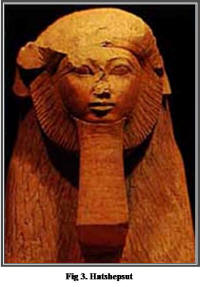 2.
Hatshepsut, Pharaoh’s Daughter? 2.
Hatshepsut, Pharaoh’s Daughter?
This daughter, Thermuthis, may have
been the renowned Hatshepsut (fig. 3), who in time came
to declare herself supreme ruler in Egypt. Two prior
queens in Egypt’s history had assumed supreme
leadership, but neither had posed and dressed as a man
as did Hatshepsut. Her relief’s and statues depict her
often in masculine clothing and wearing a ceremonial
beard.
-
She had a strong personality,
which she used to claim the throne. She proclaimed
herself ruler of both Lower and Upper Egypt and
took a king’s name, Kamare.
-
Hatshepsut was the only living
child of Thutmose I and his chief wife, Ahmose, who
could be identified as the daughter of Pharaoh who found
Moses.
-
It is possible that this daughter
may have been of a lesser wife. However, it seems more
than coincidental that one of Hatshepsut’s stature, who
could provide every advantage for Moses, lived at this
very time. Also, it would have taken someone of her
daring to rescue a Hebrew baby.
-
Because she was not male,
Hatshepsut could not accede to the throne directly. A
son of Thutmose I by a lesser wife was married to
Hatshepsut, so that her legal title might work in his
behalf. He took the name Thutmose II (1514-1504). This
man was weak in comparison to Hatshepsut and was
dominated in his rule by her.
One daughter only, Nefrure, was
born to Thutmose II and Hatshepsut, and so again a son
of the Pharaoh by a lesser wife was brought forward
as successor. This successor assumed the name Thutmose
III (1504-1450). It was after Thutmose II had died,
Thutmose III was about 10 years old, when Hatshepsut
took the daring step of assuming full control of the
kingdom.
-
During her reign, Egypt
enjoyed prosperity. She built extensively in Thebes,
like her temple, Deir el Bahri (fig. 4), and other
cities. She restored neglected sanctuaries. She added
courts and halls to the temple of Karnak. She also
increased the mining of copper and turquoise.
-
Thutmose III clearly had
been crowned before she took control and reigned perhaps
a year. But then she seized his crown; and it was not
until her death 22 years later (1503-1482), that he was
finally able to take the throne back again.
o
That Thutmose III
harbored great bitterness toward her as a result is
witnessed by his multiple defacements of her name and
representation from monuments and temples. For example,
at Hatshepsut’s temple complex at Deir el Bahri the
names and figures of Hatshepsut were destroyed wherever
found. He wished to erase her memory from the minds of
the people.
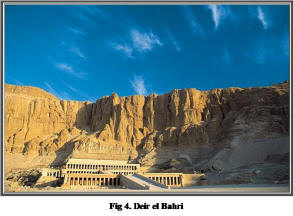 3.
Moses at the Palace 3.
Moses at the Palace
We can picture Moses in the palace
at Thebes as Hatshepsut’s adopted son.
-
Hatshepsut was married to
Thutmose II just before his accession in 1514 BC.
-
Moses did profit greatly as
verified by Stephen in the book of Acts.
AC 7:22
“Moses was educated in all the learning of the
Egyptians, and he was a man of power in words and deeds.
Acts 7:22 (NASB)
-
Hatshepsut’s own daughter,
Nefrure, died while a child, which left Moses to receive
all of Hatshepsut’s attention.
-
Born c. 1526 BC, Moses would have
been 22 years old when Thutmose III was made king
in 1504.
In the animated movie
“The Prince of Egypt” the Pharaoh is identified as
Rameses, Moses’ brother. But according to the Bible,
Rameses could not have been the Pharaoh of the Exodus.
-
Rameses is usually portrayed as the Exodus Pharaoh
because of the Bible passage
Exodus
1:8-11.
EX 1:8
Now a new king arose over Egypt, who did not know
Joseph.
EX 1:9
He said to his people, “Behold, the people of the sons
of Israel are more and mightier than we.
EX 1:10
“Come, let us deal wisely with them, or else they will
multiply and in the event of war, they will also join
themselves to those who hate us, and fight against us
and depart from the land.”
EX
1:11
So they appointed taskmasters over them to afflict them
with hard labor. And they built for Pharaoh storage
cities, Pithom and Raamses.
Exodus
1:8-11 (NASB)
-
The Bible says that the
Israelites built Raamses, and since Rameses II, who
ruled between 1304 and 1238 BC, built a royal city named
Pi-Ramesse, many assume him to be the pharaoh of the
Exodus.
-
However, excavations at
Raamses indicate that the Egyptians occupied this city
much earlier. The name Raamses itself has also been
found inscribed on a burial tomb painting from Pharaoh
Amenhotep III, who ruled nearly 100 years before
Rameses II.
-
After the
death of Thutmose II, his son, not by Hatshepsut, became
pharaoh. Thutmose III
co-reigned with Queen Hatshepsut until her death in 1482
BC. He then ruled alone until approximately 1450 BC.
-
Thutmose
III was the greatest
conqueror in Egyptian history. During his reign he had
recorded that he subdued the Ethiopians.
-
Although the
Bible does not mention these events, the historian
Josephus states the following:
“ A state of war broke out between the Egyptians and the
Ethiopians. At this time Moses had grown to be a man.
The two sides fought a great battle in which the
Ethiopians were triumphant, and they pushed to conquer
all of Egypt. The Egyptians looking for help inquired of
their priests. The priests revealed to them that they
should make Moses their general . . . Moses then became
the commander of a great army . . . In a surprise attack
against the Ethiopians, Moses led his troops to
victory.”
According to Hebrews 11:24.
HEB 11:24
By faith Moses, when he had grown up, refused to be
called the son of Pharaoh’s daughter,
Hebrews
11:24 (NASB)
-
That is, he turned down
opportunities this position afforded. This occurred
when he was 40 years old. He chose instead to help his
own people.
-
Had he not done do, some have
suggested that Hatshepsut might even have tried to make
him Pharaoh to succeed her, especially in view of the
bitterness between herself and the young deposed
Thutmose III (fig. 5).
Having made the commendable choice,
however, Moses did not carry it out wisely. He went out
among his people, saw one abused by a slave master, and
killed him. He hid the body, but the next day when he
attempted to settle a difference between two struggling
Hebrews he learned that his action of the previous day
was known.
-
Moses fled the country, giving up
in a moment what he had achieved through nearly 40
years. He knew the danger from Thutmose III if he
stayed. The animosity existing between Thutmose III and
Hatshepsut would have been shared by the two men.
Thutmose III would have been about 28 years old. This
rival of many years would now have all the excuse
necessary to take Moses’ life. Moses would not be able
to defend himself, having shown his identity with the
enslaved foreigners. He saw safety only in flight.
-
Moses escaped into the
Sinai Peninsula to the home of Jethro a priest of Midian
(Exod. 2:15-22). He
married his daughter, Zipporah, and became a shepherd.
-
40 years passed in quietness.
Most of Moses’ 40-year period in the desert had
elapsed when Pharaoh Thutmose III died
(Exod. 2:23-25). God
called Moses as he tended sheep on Mount Horeb the very
mountain where God would later give Moses The Law.
-
Using the miracle of the burning
bush as a sign, the Angel of God informed Moses that he
was to go back to Egypt and lead Israel out from
bondage.
-
Instructed by God, Aaron met
Moses in the Sinai. Moses shared God’s instructions with
him, and the two made their way to Egypt.
Josephus
also writes:
”The Pharaoh, from whom Moses had fled, died, and a
new Pharaoh had become ruler. Moses traveled to his
palace and told him of the victories he gained for Egypt
in the war against Ethiopia . . . He also spoke to
Pharaoh about what had taken place on Mount Sinai, and
when Pharaoh laughed, Moses showed him the signs.”
THE CONTEST WITH PHARAOH
Moses and Aaron went to see
Pharaoh, now Amenhotep II, son of Thutmose III, who
ascended the throne at the age of 18 in 1450 BC. He
would have been about 22 in 1446 BC at the time of the
Exodus.
-
Moses requested that
Israel be permitted to take a three-day journey into the
desert to offer sacrifices to God
(Exod. 5:1-3).
o
The king flatly refused
the request and imposed increased hardship on the
Israelites.
-
As a sign for Pharaoh, Moses then
turned his staff into a serpent
(Exod.
7:10-13).
o
Pharaoh’s magicians were
able to duplicate the miracle, which left pharaoh
unconvinced.
1. The Ten Plagues
(Exodus 7:14-12:33)
Pharaoh had been given an
opportunity to grant Moses’ request without the use of
force, but now Moses would proceed with the second step,
in which force would be used. Ten severe plagues were
brought upon Egypt. God gave particular instruction
regarding each as the time came to bring it:
1.
The water turning to blood
(Exod.
7:14-25)
2.
The frogs
(Exod. 8:1-15)
3.
The lice
(Exod.
8:16-19)
4.
The flies
(Exod.
8:20-32)
5.
The cattle disease
(Exod. 9:1-7)
6.
The boils
(Exod. 9:8-12)
7.
The hail
(Exod.
9:13-35)
8.
The locusts
(Exod. 10:1-20)
9.
The darkness
(Exod.
10:21-29)
10.
The death of the firstborn
(Exod.
12:29-33)
God gradually increased pressure
on Pharaoh to accede to Moses.
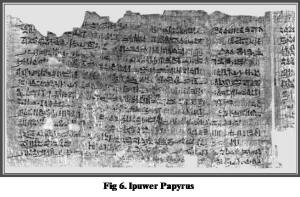 The
Ipuwer Papyrus (fig. 6) The
Ipuwer Papyrus (fig. 6)
-
In the early 19th Century an
ancient papyrus was found in Egypt. It was taken
to the Leiden Museum in Holland and interpreted by A.H.
Gardiner in 1909. The papyrus describes violent
upheavals in Egypt, starvation, drought, escape of
slaves (with the wealth of the Egyptians), and death
throughout the land. The papyrus was written by an
Egyptian named Ipuwer and appears to be an eyewitness
account of the effects of the Exodus plagues. The
account parallels the Book of Exodus.
o
Papyrus
2:10 - The river is blood.
§
Exodus
7:20 - ...all the
waters that were in the river were turned to blood.
o
Papyrus 4:14, 6:1 -
Trees are destroyed. No fruit nor herbs are found.
§
Exodus
9:25 - ...and the
hail smote every herb of the field, and brake every tree
of the field.
o
Papyrus
2:10 - Forsooth, gates, columns and walls are
consumed by fire.
§
Exodus
9:23-24 - ...the
fire ran along the ground.... there was hail, and fire
mingled with the hail, very grievous.
o
Papyrus
9:11 - The land is not light....
§
Exodus
10:22 - ...and
there was a thick darkness in all the land of Egypt.
o
Papyrus 4:3, 5:6,
6:12 - Forsooth, the children of princes
are dashed against the walls. Forsooth, the children of
princes are cast out in the streets.
§
Exodus 12:29 - And
it came to pass, that at midnight the Lord smote
all the firstborn in the land of Egypt, from the
firstborn of Pharaoh that sat on his throne unto the
firstborn of the captive that was in the dungeon.
2. The Tenth Plague
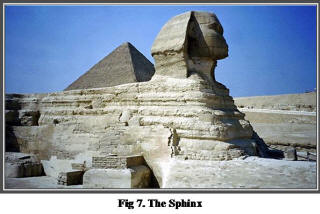 The
tenth and final plague was the slaying of Egyptian
firstborn. The eldest male child of every Egyptian
household was killed (Exod.
11:5) during the night. Only the firstborn of
Israel escaped. The
tenth and final plague was the slaying of Egyptian
firstborn. The eldest male child of every Egyptian
household was killed (Exod.
11:5) during the night. Only the firstborn of
Israel escaped.
-
Even Pharaoh’s son was included
in the slaughter, a fact possibly confirmed by an
extrabiblical text.
o
An inscription was left by
the successor of Amenhotep II, Thutmose IV. Since the
eldest son of Amenhotep II would have died on that
night, Thutmose IV must not have been the eldest. The
inscription supports that conclusion. Written on a
granite stele placed between the paws of the great
Sphinx of Giza (fig. 7), it states that the god
Harmakhis, with whom the Sphinx was identified, had
promised the young man in a dream that the kingship
would be his if he uncovered the Sphinx from the desert
sand.
o
The point is that, in
order for the young man to have been emotionally
conditioned to have such a dream, and to record it in
this way, he must have been fearful that he would not
receive the throne. But he would not have been fearful
if he had been the eldest son, for heirship to the crown
was all but automatic.
-
The severity of the tenth plague
brought quick results from Pharaoh
(Exod.
12:29-36). He called
for Moses and Aaron that same night and told them that
Israel could leave the land.
-
The next day all Israel
began the long awaited move out of Egypt.
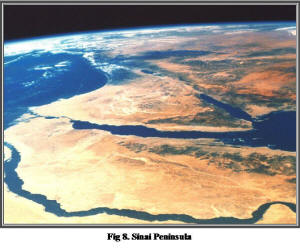 1.
Route Through Egypt 1.
Route Through Egypt
Israel’s assembly point was the
city of Raamses (Exod. 12:37).
-
The route taken from Raamses led
through Succoth (Exod.
12:37; 13:20),
which is identified with Tell el-Maskuta. This Tell lies
32 miles southeast of ancient Tanis, in the likely
direction of Israel’s march.
-
Israel then came to Etham, which is unknown, but
may be the name of a district lying along both sides of
the northern end of the Red Sea. The area through which
Israel traveled south for three days after crossing the
Red Sea is also called Etham
(Num. 33:6-8). Here some change in direction of
travel occurred as instruction came to “turn back” and
“encamp near Pi-hahiroth, between Migdol and the sea,
before Baal Zephon” (Exod.
14:2), these places being unknown. Both Pi-hahiroth
and Migdol are found mentioned in Egyptian inscriptions,
but have not been identified.
-
At this point they were on the
shore of an extensive body of water that barred further
progress. This body of water is called yam suph,
meaning “Sea of Reeds”
(Exod. 13:18).
-
Three matters argue that the body
of water was not the Red Sea proper (Gulf of
Suez):
1.
The Gulf of Suez is too
far south to have provided a logical place of exit from
the country.
2.
The biblical account
(Exod.
13:20-14:3; Num. 33:6-8)
implies that the yam suph divided between
productive Egyptian soil and the desert. If the people
went as far south as the Gulf of Suez, they would have
encountered much desert before reaching it.
3.
When they had crossed this body
of water, they found themselves in the “Desert of
Shur” (Exod. 15:22),
which was in the northern part of the Sinai Peninsula,
hardly as far south as the Gulf of Suez. Shur is
mentioned five other times in the Old Testament and
always as located just south of Canaan or on the way to
Egypt (Gen. 16:7; 20:1; 25:18;
1 Sam. 15:7; 27:8).
-
A more likely identification for
yam suph, is the water of the Bitter
Lakes, which may even have been an extension of the Gulf
of Suez in that day.
2. The Plight at the yam suph
On reaching the yam suph,
the people were barred from further progress by the
extensive body of water. They learned that they were
being pursued. Pharaoh, hearing of the direction in
which they were headed and calculating that they would
encounter the water, had changed his mind and sent his
chariot corps after them (Exod.
14:6-10). At this point,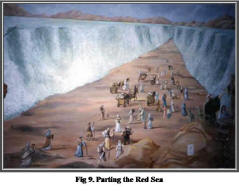 God intervened to deliver His people with three
distinct miracles:
God intervened to deliver His people with three
distinct miracles:
- Moving the Cloud
(Exod. 14:19-20).
The first was a shift in position of the
cloud, which had been leading. From standing out
over the water before the camp, it now moved
directly overhead to stand behind it. This
accomplished two things: it stopped the Egyptians,
settling down on them like a fog so that they could
not see, and it provided light on the Israelite side
so the people could see better.
- Parting the Sea
(Exod. 14:21-22).
The second miracle was the dividing of the water so
that the people could cross to the other side. We
are told that as part of the miracle, God
“all that night drove the
sea back with a strong east wind” (Exod. 14:21).
The wind is said to be particularly effective on the
Bitter Lakes in changing water levels (fig. 9).
- Closing the Sea
(Exod.
14:23-31).
The third miracle was the closing of the water so
that the pursuing Egyptians were drowned. As the
last of the Israelites moved into the dried path,
the cloud began to move ahead of the Egyptians so
that they could once more see to take up the chase.
God released the waters and they rolled down upon
the helpless Egyptians.
Did Pharaoh Drown in the Red Sea?
There are two possibilities:
- Amenhotep II did not die at
this time; he lived another 22 years after this. His
mummy was found in the Valley of the Kings in 1898.
In one of the side rooms of his tomb were found nine
other royal mummies, including those of Thutmose IV,
Amenhotep III, and Merneptah.
-
Exodus
14:6 suggests that Pharaoh personally assembled
the army and possibly even accompanied them at the
start, but no indication is made that he was involved in
the closing waters. He is not mentioned after
Exodus 14:10.
-
Psalm
136:15 says that Pharaoh and his army were
overthrown, not necessarily requiring that Pharaoh was
killed.
-
According to the Bible, after the ten plagues God
sent against Egypt, Israel departed, but Pharaoh led
his army in pursuit of them at the Red Sea. The
Bible records the following:
EX 14:23
Then the Egyptians took up the pursuit, and all
Pharaoh’s horses, his chariots and his horsemen went in
after them into the midst of the sea.
EX 14:24
At the morning watch, the
LORD
looked down on the army of the Egyptians through the
pillar of fire and cloud and brought the army of the
Egyptians into confusion.
EX 14:25
He caused their chariot wheels to swerve, and He made
them drive with difficulty; so the Egyptians said, “Let
us flee from Israel, for the
LORD is
fighting for them against the Egyptians.”
EX 14:26
Then the LORD
said to Moses, “ Stretch out your hand over the
sea so that the waters may come back over the Egyptians,
over their chariots and their horsemen.”
EX 14:27
So Moses stretched out his hand over the sea, and the
sea returned to its normal state at daybreak, while the
Egyptians were fleeing right into it; then the
LORD
overthrew the Egyptians in the midst of the sea.
EX 14:28
The waters returned and covered the chariots and the
horsemen, even Pharaoh’s entire army that had gone into
the sea after them; not even one of them remained.
Exodus
14:23-28 (NASB)
The
Bible also says in Psalm:
PS 136:13
To Him who divided the Red Sea asunder, For His
lovingkindness is everlasting,
PS 136:14
And made Israel pass through the midst of it, For His
lovingkindness is everlasting;
PS 136:15
But He overthrew Pharaoh and his army in the Red Sea,
For His lovingkindness is everlasting.
Psalm
136:13-15 (NASB)
-
Some people
do not believe that the Pharaoh perished in the waters
of the Red Sea because
the tombs of both Pharaoh Thutmose III and his
successor, Amenhotep II, have been found.
But if one reads Exodus 14:30
carefully it states the following:
EX 14:30
Thus the LORD
saved Israel that day from the hand of the
Egyptians, and Israel saw the Egyptians dead on the
seashore.
Exodus
14:30 (NASB)
o
This passage indicates
that the dead bodies of the Egyptians were deposited on
the shore of the Red Sea. This would have allowed
the Egyptians access to his body for burial.
o
This is support for the
Exodus Pharaoh being Thutmose III.
Although the Bible never
specifically identifies the pharaoh of the Exodus by
name, it does tell us the exact date of the Exodus.
-
1Kings 6:1
states that Solomon began building the Temple in the
fourth year of his reign, 480 years after the Exodus.
Most bible scholars agree that the fourth year of
Solomon’s reign was 966 BC.
So the date of the Exodus can
be calculated: 966 + 480 = 1446 BC.
According to history, Rameses II did not begin his reign
until around 1304 BC, so he could not have been the
Exodus pharaoh.
1. Direct Biblical Evidence
-
1 Kings 6:1.
The first reason listed for the 1446 date is the
statement of 1 Kings 6:1
that the Exodus preceded the time when Solomon began
to build the temple (c. 966 B.C.) by 480 years.
Adding 480 years to 966 BC gives the date 1446 BC.
- Jephthah’s statement.
The second reason listed is that Jephthah speaks
of Israel as having possessed the land of Palestine,
at his time, for a period of 300 years
(Judg. 11:26).
Jephthah was the eighth judge of Israel.
-
The total years represented by
Samuel’s time of leadership, the kingships of Saul and
David, and four years of Solomon’s reign must be added
to the date 966 BC, when the construction of the temple
began, to arrive at Jephthah’s date. This works out to
approximately 1100 BC, which is just three hundred years
after 1400 BC, the time of the conquest.
- Historical correlations.
The third reason listed concerns a better
correlation between the events of Scripture and
Egyptian history. The biblical account of the Exodus
fits Egyptian history well if the Exodus occurred in
the fifteenth century, not if it was in the
thirteenth.
-
The identity of the king who
died while Moses was in Midian
(Exod. 2:23-25).
The rationale for the mention of his death in the
biblical record is that the death made possible Moses’
return to Egypt, which strongly suggests that the one
who died was the same as the one from whom Moses fled 40
years before (Exod. 2:15).
-
Whenever the Exodus occurred,
then, a Pharaoh who had ruled at least 40 years must
have just died. Such a death had just occurred; namely
of Thutmose III, who died in 1450 BC, just four
years before the date of Exodus (1446 BC). Also, he had
ruled alone since 1482 BC, and before this he had ruled
jointly with his aunt/stepmother Hatshepsut (1504-1482),
long enough to be the one from whom Moses had fled.
2. Extrabiblical Evidence
- Pithom and Raamses.
The first concerns the building of Pithom and
Raamses by enslaved Israelites. In spite of the
chronological difficulty in harmonizing the
biblical statements with Egyptian history in the
thirteenth century, many late-date adherents say
that this reference in
Exodus 1:11 supports their position. Since
Exodus 1:11 uses
the name Raamses for the city ordered built
by the Pharaoh, this one must have been Rameses II.
-
This is an impressive argument,
but the Raamses site was occupied much earlier. In
addition, the name Raamses had already been used
by the Hyksos kings many years before the Nineteenth
Dynasty. Therefore, it was probably the Hyksos who
forced the Israelites to build Pithom and Raamses.
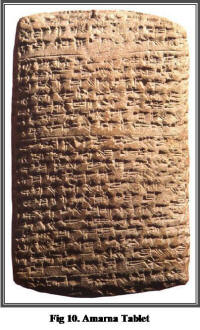 b.
The Amarna Tablets.
The Tablets are letters written between c. 1400 and
1367 BC to the Egyptian courts of Amenhotep III
and Akhenaton, mostly by Canaanite city-kings. The
letters reveal a chaotic condition of plot, counterplot,
and contradictory accusations between Canaanite rulers.
There is also frequent mention of trouble from a people
called Habiru. Since there is possible equivalency in
name between “Habiru” and “Hebrew” and since the
disturbances wrought by these people are approximately
at the time of the Israelite conquest, it is possible
to identify these Habiru with Joshua’s invading forces
(fig. 10). b.
The Amarna Tablets.
The Tablets are letters written between c. 1400 and
1367 BC to the Egyptian courts of Amenhotep III
and Akhenaton, mostly by Canaanite city-kings. The
letters reveal a chaotic condition of plot, counterplot,
and contradictory accusations between Canaanite rulers.
There is also frequent mention of trouble from a people
called Habiru. Since there is possible equivalency in
name between “Habiru” and “Hebrew” and since the
disturbances wrought by these people are approximately
at the time of the Israelite conquest, it is possible
to identify these Habiru with Joshua’s invading forces
(fig. 10).
c.
Military campaigns
of Seti I and Rameses II. The last matter to
notice concerns the Palestinian military campaigns of
two Egyptian Pharaohs, Seti I and Rameses II. Late-date
adherents argue that, if Israel were in Palestine
at the time of these campaigns, which would have been
true on the early-date basis, the campaigns should be
mentioned in the Book of Judges, a book given largely
to military activities; and, since they are not, Israel
must not yet have been there.
-
The evidence. Seti
I campaigned northward already in his first year (1316
BC), encountering enemy forces in northern
Palestine and slightly beyond. In a later campaign he
pressed as far as Kadesh on the Orontes River, where he
made a treaty with the Hittite king, Muwatallis. Rameses
II followed with other campaigns, notably in his fifth
and 21st years, in the last of which he made
his famous treaty with the Hittite Hattusilis III (1283
BC). In each of these campaigns, the Egyptian army had
to march through the length of Palestine and must have
come in contact with Israelites, if indeed they were
there.
-
Both Seti I and Rameses II also
appear to have engaged in actual warfare in
Palestine itself. At least both left a stele at
Bethshan; and Seti I tells of his clashing with Apiru
near that city, a reference certainly to the Hebrews in
which the term “Habiru-Apiru” is used again. These
Palestinian activities do make the question pertinent as
to why, if Israel was in the land at the time, the Book
of Judges gives no record of them.
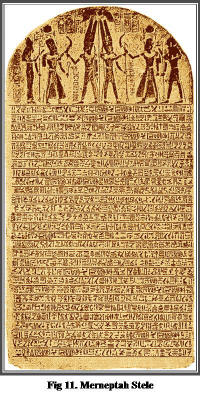 -
The explanation.
In reply, two observations may be made. First, later
military inroads into Palestine by Merneptah
(1238-1228) and Rameses III (c l195-1l64) are not
mentioned in the Book of Judges either, and the
campaigns of each did follow the time of Israel’s
entrance into Canaan, even on the late-date basis.
Merneptah, as already noted, claims to have wrought
extensive havoc in Palestine, stating that “Israel is
laid waste, his seed is not” on the Merneptah Stele
(fig. 11). Rameses III of the Twentieth Dynasty boasts
of having reduced both the “Tjeker and the Philistines”
to ashes. He even had scenes of the campaign he
conducted into Palestine depicted on the walls of his
famous temple of Medinet Habu. He seems to have had a
major interest in the Bethshan area. -
The explanation.
In reply, two observations may be made. First, later
military inroads into Palestine by Merneptah
(1238-1228) and Rameses III (c l195-1l64) are not
mentioned in the Book of Judges either, and the
campaigns of each did follow the time of Israel’s
entrance into Canaan, even on the late-date basis.
Merneptah, as already noted, claims to have wrought
extensive havoc in Palestine, stating that “Israel is
laid waste, his seed is not” on the Merneptah Stele
(fig. 11). Rameses III of the Twentieth Dynasty boasts
of having reduced both the “Tjeker and the Philistines”
to ashes. He even had scenes of the campaign he
conducted into Palestine depicted on the walls of his
famous temple of Medinet Habu. He seems to have had a
major interest in the Bethshan area.
-
It is clear that both Ramses
III and Merneptah centered attacks on the
Palestine sector itself and did not merely pass
through, as was true mainly for both Seti I and Rameses
II (whose activities are likewise omitted in the Book of
Judges).
-
One may conclude from this that,
if their campaigns are not mentioned when Israel
surely was in the land, then that the earlier campaigns
are not mentioned need not be evidence that Israel was
not in the land at this time.
Israel’s task, now that she was out of Egypt and across
the yam suph, was to go to Canaan. The shortest
way to Canaan lay northeast. From Israel’s present
location on the east side of the yam suph to
southern Canaan was approximately 150 miles, which had
the people gone directly would have taken less than a
month to traverse.
ISRAEL’S ROUTE OF TRAVEL
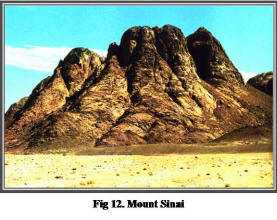 The
route of Israel runs south along the Red Sea for over
100 miles and then diagonally inland toward modern Jebel
Musa (Mount Sinai) nearly 50 miles. From this point,
where Israel remained for nearly a year, it leads north
to Kadesh-barnea at the southern end of Canaan. The
route of Israel runs south along the Red Sea for over
100 miles and then diagonally inland toward modern Jebel
Musa (Mount Sinai) nearly 50 miles. From this point,
where Israel remained for nearly a year, it leads north
to Kadesh-barnea at the southern end of Canaan.
-
The key to determining the route
is the location of Mount Sinai. The traditional
view identifies it with Jebel Musa in the southern Sinai
Peninsula (fig. 12).
TO MOUNT SINAI
1. Marah, Elim, Wilderness of
Sin
a.
Water
(Exod.
15:22-27).
Israel watched the overthrow of the Egyptian army
from the eastern shore of the yam suph; paused to
give praise to God (Exod.
15:1-21), and proceeded to follow the directing
cloud southward. Three days they traveled without
finding water. They finally came to a small oasis called
Marah, but its water was bitter. Marah has commonly been
identified with modern Hawarah, where the water is still
bitter. Moses, at God’s direction, cast a piece of wood
into the water, and it immediately became sweet and
drinkable.
-
The people moved on to Elim,
which is believed to be present-day Wadi Ghurundel,
about six miles south of Hawarah, where plenty of sweet
water is still to be found.
-
Then the people moved on to a
region called “Desert of Sin”
(Exod. 16:1). This is
best identified with a sandy, easily traveled plain
along the shore of the Red Sea, since the terrain just
inland is rugged.
b. Manna
(Exod. 16:1-36).
It was here that Israel’s food supply ran out. The
Israelites became anxious and cried to Moses. Where
would adequate food be found in such a desolate region?
-
God’s provision turned out to be
a nourishing food in the form of “thin flakes like
frost,” described as white, like coriander seed and
tasted like wafers made with honey, which the people
called “manna” (Exod. 16:14,
15, 31). It lay on the ground fresh each morning
except the Sabbath.
2. Rephidim and Mount Sinai
(Exodus 17:1-19:3)
From the wilderness of Sin, Israel
turned inland, perhaps moving up Wadi Feiran, which
leads toward Jebel Musa, and came to a place called
Rephidim, sometimes identified with Wadi Refayid.
Rephidim was near Mount Sinai, for it was here that God
told Moses to smite the “rock in Horeb” to bring water
for the people.
a. Water from the Rock
(Exod. 17:1-7).
At Rephidim the people found their water depleted. The
people complained to Moses, who brought the need to God.
Following instructions, Moses struck the rock of Horeb,
and water in great quantity gushed forth. The people’s
thirst was satisfied.
b. Amalekite Battle
(Exod. 17:8-16).
Also at Rephidim, the Israelites encountered a roving
band called Amalekites in battle. This band may have
descended from Esau (Gen.
36:12), even as the Edomites
(Gen. 36:1). Though not
directly stated, the Amalekites apparently had been
attacking the weak and stragglers of Israel since the
crossing of the yam suph
(Deut. 25:17-18).
Consequently, Moses instructed Joshua, one in whom he
had learned to place confidence, to choose men for
engaging the raiders in battle.
-
The battle was fought the
following day, and God gave a victory. Moses, observing
from a nearby hill, raised his arms toward God in a
gesture of supplication, and, as long as his arms were
held upright, Joshua’s troops advanced, but when his
arms tired and were lowered, his soldiers were forced to
retreat. Finally, Aaron and Hur, standing on either side
of Moses, assisted their leader in maintaining his arms
upright until full victory was achieved.
-
Hur was Moses’ brother-in-law,
the husband of Miriam, as Josephus states.
“…and Hur their sister Miriam’s
husband.”
c. Arrival at Mount Sinai
(Exod. 19:1-2).
The next stop was at Mount Sinai, best identified with
one end of a mountain ridge about two miles long and one
mile wide. Only the southern peak of this mountain is
Jebel Musa (7,363 feet high), while the northern peak is
called Ras es-safsafeh (6,540 feet). During this time
the Law was to be given and the tabernacle built.
GIVING THE LAW
1. The Ten Commandments
(Exodus 19:3-20:17)
The first aspect of God’s
communication to Israel at Sinai was His proclamation
of the Ten Commandments (Exod.
20:1-17). God began to speak audibly from the
mountain so that all could hear. When the Voice ceased,
the people urged Moses to act as their mediator, so that
they would not have to hear more in this direct, fearful
manner (Exod. 20:19).
a. First Forty Days
(Exod. 24:12-18).
God called Moses up the mountain to begin a
period of revelation lasting 40 days. Moses took Joshua
with him, leaving Aaron and Hur in charge of the camp.
For six days Moses stayed at a point only part way up
the mountain, apparently still with Joshua, but on the
seventh day God called him on alone. He remained in
God’s presence continuously for 40 days as God revealed
the Law to him. At some point during this time, God also
inscribed the Ten Commandments on two tables of stone.
b. Golden Calf
(Exod. 32). On
the 40th day, God told Moses that the people had sinned
in making a golden calf as an object of worship. Moses
immediately returned to camp and in a display of
righteous indignation, broke the two inscribed stone
tablets in the sight of the people, utterly destroyed
the gold calf, reprimanded a flustered Aaron who had
consented to the sin, and instructed Levites to slay
guilty Israelites, which they did to the number of three
thousand.
c. Second Forty Days
(Exod. 34:1-35).
Moses was now instructed to cut two more tablets of
stone and return to the top of Sinai. He did so the
following morning, and for 40 more days God revealed the
Law to him.
The Mosaic Law includes the Ten Commandments given
orally to all the people, the “Book of the Covenant”
given to Moses alone later the same day, and the
lengthy, detailed regulations revealed to Moses, during
the two 40-day periods on Mount Sinai. The total content
may be divided into moral, civil, and ceremonial law.
Comparison
with other laws
The Mosaic Law has been compared
with other legal codes. Six are known:
- The Urnammu Code, c. 2050 BC,
from the Third Dynasty of Ur.
- The code of Bilalama, c. 1925
BC, from Eshnunna.
- The code of Lipit-Ishtar, c.
1860 BC, from Isin.
- The code of Hammurabi, c.
l700 BC, from Babylon.
- The Hittite code, c. 1450 BC,
from Boghazkoi.
- The Assyrian code, c. 1350 BC,
from Assur.
The analysis of these codes has
revealed numerous parallels with the laws of the Old
Testament. The recognition of similarities does not
negate the uniqueness of Old Testament law. God used
compatible cultural forms to frame the elements of His
Word. This uniqueness is to be found in the context of
God’s covenant relationship with Israel.
-
The laws of the Old Testament are
to be understood as the stipulations assigned to the
subject people by the Great King, who in this case is
God. What they teach us is that God is concerned with
humanity’s relationship with Him, but is also concerned
that the relationship demonstrates itself in justice and
equitable treatment of one person by another.
THE TABERNACLE
(Exodus 25-31; 35-40)
One of the main subjects in God’s
communication to Moses was the tabernacle. In contrast
to Egypt and other countries where many temples existed,
Israel was to have only one place of worship.
-
For the period of wilderness
travel, and also for many years after occupying
Palestine, this place was to be a portable sanctuary
called the tabernacle, for which God gave Moses the
plan.
-
Bezaleel of the tribe of
Judah and Aholiab of the tribe of Dan were to lead in
the construction (Exod.
35:30-35). Freewill offerings of the people
quickly provided ample building material
(Exod. 35:4-29). The
importance of this structure was stressed by the large
place given to it in the Law and its assigned central
location among the tribes.
1. Description
 The
tabernacle (fig. 14) consisted of a portable building
located within a rectangular court. The court measured
150 feet by 75 feet, and was enclosed by linen curtains
hung from silver hooks on silver-covered rods attached
to posts of acacia wood. The
tabernacle (fig. 14) consisted of a portable building
located within a rectangular court. The court measured
150 feet by 75 feet, and was enclosed by linen curtains
hung from silver hooks on silver-covered rods attached
to posts of acacia wood.
-
Entrance was from the east
through a gate of curtains. Two articles of furniture
were located in the eastern half of the court. Nearest
the entrance was the brazen altar where the priest
offered sacrifices for the people. It measured 7.5 feet
square and 4.5 feet high, was made of acacia wood
covered with bronze, and had horns at each corner.
Beyond the altar was the laver. This was made of bronze
and was the place where priests washed.
In the western half of the court
stood the tabernacle proper, a rectangular building 45
feet long, 15 feet wide, and 15 feet high, constructed
of 48 frames of acacia wood covered with gold. The
building had four layers of covering: the first of
linen, the second of goat’s hair, the third of dyed
rams’ skins, and the fourth of dugong skins. It
consisted of two compartments:
-
The first, called the Holy
Place, comprising two-thirds of the area and containing
the seven-light lamp stand, the table of showbread, and
the altar of incense.
-
The second, called the Holy of
Holies, containing the Ark of the Covenant (fig. 15),
which supported two golden cherubim with outstretched
wings.
-
The ark contained the Ten
Commandments, a gold pot of manna, and later Aaron’s rod
that budded (Num. 17:1-13;
Heb. 9:4).
2. Location
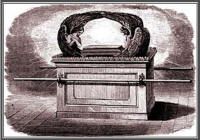 God
directed that the tabernacle be located in the exact
center of the tribes, when encamped during the
wilderness journey. When marching the tabernacle
furniture was to be kept in the center, though the
tabernacle itself was to go earlier so that it might be
erected in time for the furniture to be set in place on
arrival (Num. 10:21). God
directed that the tabernacle be located in the exact
center of the tribes, when encamped during the
wilderness journey. When marching the tabernacle
furniture was to be kept in the center, though the
tabernacle itself was to go earlier so that it might be
erected in time for the furniture to be set in place on
arrival (Num. 10:21).
-
One item of furniture went before
all, the Ark of the Covenant, which led the way, with
the priests carrying it as they followed the pillar of
cloud moving overhead.
3. Service instituted
The next matter was the
consecration of Aaron and his sons, Nadab, Abihu,
Eleazar, and Ithamar, to act as priests for ministering
at the tabernacle (Exod.
29:1-37; 40:12-15; Lev. 8:1-36). All five were
washed with water, clothed in the prescribed priestly
garments, and anointed with oil.
SINAI TO KADESH-BARNEA
Eleven months and five days had
elapsed at Sinai (Num. 10:11)
when the pillar of cloud lifted, leading Israel north in
the direction of Canaan. A covenant had been made
between God and the people, an organization
established, and the tabernacle built. The people were
ready to move on to the Promised Land.
1. The Route
The route north led to
Kadesh-barnea, a city located at the southern extremity
of Canaan. Its location is reasonably sure between two
sites lying about 50 miles southwest of Beersheba, Ain
Qudeis and Ain Qudirat. The first retains the name
Kadesh, both are only five miles apart.
On the way an incident occurred
with insubordination by Aaron and Miriam
(Num. 12:1-15). These
two, already enjoying places of honor, rejected Moses’
marriage to an Ethiopian and wanted greater authority,
claiming that God had spoken by them as well as by
Moses.
-
God called all three before the
tabernacle, and, speaking out of the pillar of cloud,
made known His appointment of Moses, saying that Moses
had been honored above even the prophets in being
privileged to speak with God “face to face.” He then
brought punishment on Miriam by smiting her with
leprosy for one week.
Moses marriage to Zipporah had
occurred over 40 years earlier. Zipporah had probably
died and Moses married again. The marriage was not
contrary to the Law, which forbade marriage to
Canaanites (Exod. 34:16).
-
Josephus
also mentions that Moses married an Ethiopian woman:
“Because of the bravery of Moses, The daughter of the
king of Ethiopia, Tharbis, saw Moses and fell madly in
love with him. She sent to him a delegation of her most
trusted servants to propose marriage. He accepted, on
the condition that she would surrender the city over to
him . . . After Moses had punished the Ethiopians, he
praised God and then celebrated his marriage.”
-
The Bible
also mentions his Ethiopian wife in Numbers 12:1.
Nu 12:1
And Miriam and Aaron spake against Moses because of the
Ethiopian woman whom he had married: for he had married
an Ethiopian woman.
Numbers
12:1 (KJV)
2. Refusal to Enter the Land
When Israel arrived at Kadesh, the
first matter of business was to reconnoiter Canaan. God
directed the appointment of 12 men, one from each tribe,
to act as spies. These were instructed to investigate
the food production of the land and the people’s
strength for self-defense.
-
For 40 days the 12 traversed the
land as far north as Rehob, located near the city of
Laish, later called Dan (Judg.
18:28-29). All agreed in their report. The land
was good for food supply but would be very difficult to
conquer because the people were strong, giants lived in
the land, and the cities were walled
(Num.
13:27-28).
-
They differed in their
evaluation. Ten said the difficulties were too great,
which meant returning to Egypt
(Num. 13:31-33); two, Caleb and Joshua, asserted
that God could give victory in spite of the
difficulties, pleading that Israel not rebel against God
by refusing to enter the land
(Num. 13:30; 14:6-9). The people heeded the ten,
even threatening to kill the two, and began planning to
return to Egypt under new leadership, if need
be.
-
As a result, God threatened to
annihilate Israel in punishment, but again Moses
interceded for the people, this time on the basis of
God’s own reputation (Num.
14:11-20).
-
God then said the nature of the
punishment would be that the entire nation, rather than
entering the land, would remain in the desert wilderness
for a total of 40 years and that every Israelite 20
years and older, with the exception of Caleb and
Joshua, would die during this time and never enter the
Promised Land (Num. 14:20-35).
FORTY YEARS OF
WANDERING
At this point, Israel began
approximately 40 years of fruitless wandering in the
Sinai desert. Very little is recorded from these years,
for clearly this was a time intentionally devoid of
profit or progress for a disobedient people. The nation
had been given opportunity to move into the land of
blessing but had refused. Now the people should wander
in unpleasant conditions, with nothing positive
accomplished, until all over 20 years of age had died.
-
Only one incident is recorded
from all these years. That was a revolt of 250 people
led by two Reubenites (Dathan and Abiram) and the Levite
Korah (Num. 16-17).
These leaders desired places of authority along with, or
in place of, Moses and Aaron.
-
God vindicated Moses and Aaron by
opening the earth to swallow Korah, Dathan and Abiram,
along with their households and bringing fire to consume
the 250 supporters of the rebels. When many Israelites
complained at this harsh treatment, God sent a plague
through the camp, which took the lives of 14,700 of
these complainers (Num.
16:23-35, 41-50).
-
Further, to show Aaron’s
approved position, God caused Aaron’s rod, placed in
the tabernacle at God’s direction, to bud, in contrast
to the rods placed there by other tribal heads
(Num. 17:1-11).
KADESH-BARNEA TO THE JORDAN
1. Water Again from a
Rock
(Numbers
20:2-13)
On arriving back in Kadesh at this
time, the people lacked water once more. The reply was
that Moses and Aaron were to gather the people at a
certain rock; water would flow from it, as had occurred
earlier at Rephidim.
-
This time, however, God
instructed Moses only to “speak” to the rock, saying
nothing about striking it. But Moses struck it twice,
and cried to the people, “Must we bring you water out of
this rock?” Water came forth, but Moses’ action and
words made it appear as though his human effort had
helped to produce it.
-
God was displeased and pronounced
punishment on Moses, stating that now he would not be
permitted to enter the Promised Land
(Num.
20:12; 27:12-14; Deut.
32:48-52).
2. Request to Pass
Through Edom
(Numbers
20:14-21)
While at Kadesh, Moses sent
messengers to the King of Edom requesting passage
through his land. The plan now was to skirt the southern
end of the Dead Sea, march north on its east side, and
enter Canaan heading west. Moses promised to stay
strictly to the “King’s Highway.”
Nu 20:17
Please let us pass through your country. We will not go
through any field or vineyard, or drink water from any
well. We will travel along the king’s highway and not
turn to the right or to the left until we have passed
through your territory.”
Numbers
20:17 (NASB)
-
Using this term, Moses is
referring to an ancient, well-known, north-south road,
identified in recent times and traced as far north as
Syria. It had been used by the four eastern kings
of Genesis 14, was
later paved by the Romans, and is today followed closely
by a modem Jordanian highway (fig. 16).
-
Even though Moses promised not to
stray from this “highway,” the Edomite king refused
passage. This meant a tedious journey south to
Ezion-geber again (Deut. 2:8),
where the people had been only shortly before
(Num. 33:35), and then
a return on the eastern side of Edom.
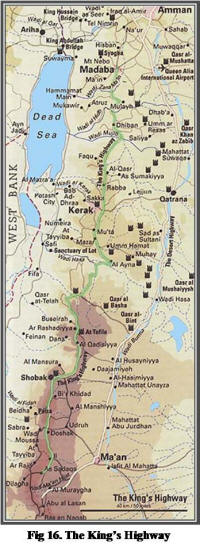 3.
Death of Aaron 3.
Death of Aaron
En route Aaron died on Mount Hor at
the age of 123.
-
Aaron died the first day of the
fifth month of the fortieth year
(Num. 33:38), just five
months after Miriam’s passing. Instructed of God, Moses
accompanied Aaron, with Eleazar, Aaron’s son and
successor, to the top of the mountain, and there he
placed Aaron’s clothes on Eleazar before Aaron’s life
was taken. The people remained in mourning at
Mount Hor for 30 days.
-
While they were there, a brief
battle occurred (Num. 21:1-3).
Arad, king in the southern part of Canaan,
led an assault against Israel. Initially defeated,
Israel looked to God for help and then thoroughly routed
the foe, even pressing on to destroy several of the
cities in Arad’s kingdom.
4. Return North and
Victory over Sihon and Og
(Numbers
21:10-35)
Following God’s instructions not to
interfere with the Edomites (Deut.
2:4-5), Israel skirted their territory on the
east and again made her way northward. Coming to the
brook Zered, Moab’s southern boundary, God forbade
interference with Moab also
(Deut. 2:9). Israel obeyed and followed a path
well to the east.
-
The Zered is a small stream that
flows into the southern extremity of the Dead Sea
from the southeast.
Interference from King Sihon’s
kingdom was unavoidable. His land stood between Israel
and the Jordan River. Moses asked for permission to
cross the land but was refused. Sihon mustered his army
at Jahaz, and Moses met and defeated him. Then Israel
occupied all Sihon’s territory to the Jabbok River.
-
With this victory Israel’s
forces were not far from the country of Og, the powerful
king of Bashan, who ruled from the Yarmuk River as far
north as Mount Hermon. Now Moses took the offensive and
defeated Og at his important city, Edrei
(Num.
21:33-35), before
moving on to occupy his land.
-
Israel now controlled most of the
land from the Arnon River in the South (Moab’s northern
boundary) to Mount Hermon in the north, a distance of
130 miles.
-
The defeat of these kings was
really the beginning of the conquest, for the territory
east of the Jordan would eventually be allotted
to Gad, Ephraim, and half of the tribe of Manasseh.
These victories were important, too, in impressing the
Canaanites across the Jordan with the power of God
exercised on Israel’s behalf
(Josh. 2:9-11; 9:8-10).
AT THE JORDAN
1. Balaam and the Moabites
(Numbers 22-25; 31)
With these significant victories
won, Moses assembled the army near the Jordan River
opposite Jericho. Here Balak, king of Moab, viewed
Israel as a menace to his country and, in cooperation
with elders of Midian, sent messengers far north to
Pethor on the Euphrates River to bring Balaam, a prophet
whose reputation had reached this far south, to place a
curse on Israel (Num. 22-24).
-
However, once with Balak, Balaam
only blessed Israel instead of cursing her.
-
Then after Balak had dismissed
him in disgust, Balaam uttered yet a fourth message
(Num. 24:14-25), in
which he gave a prediction regarding the coming Messiah
and future blessing of Israel.
-
Finally, however, the prophet did
work in Moab’s favor. He advised Balak to entice
Israelite men to take part in the cult activities of
Baalpeor (Num. 25:1-18).
Balak followed Balaam’s advice and many Israelites were
ensnared. As a result of this excursion into idolatry,
God sent a punishing plague, which took 24,000 Israelite
lives.
-
Moses then dispatched an army of
12,000 to punish Midian, which had been partner with
Moab from the start. The Midianites were
defeated, and all the males, the kings of Midian, and
Balaam himself were killed
(Num. 31:1-54).
Has Evidence of Balaam been found?
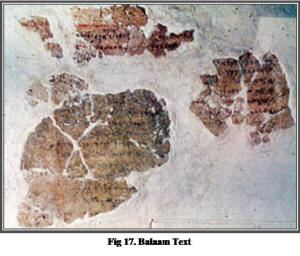
Balaam came from Pethor, a
Mesopotamian city, identified with Pitru of Assyrian
texts, located 12 miles south of Carchemish, about 400
miles away. Balaam was a diviner-prophet. An ancient
text found at Deir Alla, Jordan, in 1967 tells about the
activities of a prophet named Balaam. Could this be the
Balaam of the Old Testament? The text makes it clear
that it is.
-
Three times in the first four
lines he is referred to as “Balaam son of Beor,” exactly
as in the Bible.
-
The remarkable text found at Deir
Alla consists of 119 fragments of plaster inscribed with
black and red ink. It was among the rubble of a building
destroyed in an earthquake. It seems to have been one
long column with at least 50 lines, displayed on a
plastered wall.
-
Written in Aramaic, the text
begins with the title “Warnings from the Book of Balaam
the son of Beor. He was a seer of the gods.” It is in
red ink, as are other portions of the text where
emphasis is desired. The reference to the “Book of
Balaam” indicates that the text was part of a
pre-existing document and therefore the original date of
the material is much earlier than the plaster text
itself. Balaam goes on to relate a vision concerning
impending judgment from the gods.
2. Anticipatory
Matters
Moses now did several things in
anticipation of Israel’s entrance into the land.
-
First, he had another census
taken (Num. 26).
Thirty-nine years of wilderness wandering (with
1,200,000 deaths) had transpired since the census at
Mount Sinai. There was need to know Israel’s
present manpower as she faced the challenge of Canaan.
The number counted this time was 601,730 men 20 years
and older, in comparison with the earlier 603,550
(Num. 1:46).
-
Another important matter was the
appointment of a new leader. Someone had to be selected
to take the place of Moses and lead Israel across
the Jordan. God’s choice was Joshua
(Num. 27:15-23). He and
Caleb were the only older men who could enter the land,
for all others their age either had died or would die
before that time.
o
Joshua had led in battle
against the Amalekites (Exod.
17:8-14). He had accompanied Moses part way up
Mount Sinai at the time of receiving the Mosaic
Law (Exod. 24:13). He
had assisted Moses following Israel’s repentance
regarding the sin with the golden calf
(Exod. 33:11). He had
served as one of the twelve spies of Canaan and urged
advance into the land along with Caleb
(Num. 13:8; 14:6-9). In
all these instances, Joshua demonstrated responsibility
and leadership.
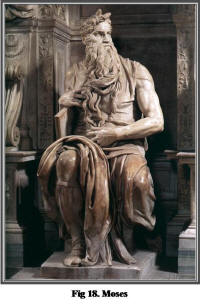 o
God revealed the
selection of Joshua to Moses, who then made proper
announcement to the people and gave appropriate charge
to the new leader. o
God revealed the
selection of Joshua to Moses, who then made proper
announcement to the people and gave appropriate charge
to the new leader.
With the work both of leadership and writing
complete, and a replacement now appointed, Moses, at
age 120, was ready for God’s call to heaven. Few men in
all history could claim to have had so rich an
experience; few so used of God. He was gifted and
trained as perhaps none other of his day, and he was
entrusted with a task probably greater than any other
person of any day. But now his work was done. According
to God’s instruction, he climbed “to the top of Pisgah,
across from Jericho,” surveyed the promised Land, heard
God remind him that this was indeed the land that had
been promised long before, and then was taken in death
by God. He was buried in an unknown grave in a nearby
valley (Deut. 34:1-7).
|



 -
- 2.
Hatshepsut, Pharaoh’s Daughter?
2.
Hatshepsut, Pharaoh’s Daughter? 3.
Moses at the Palace
3.
Moses at the Palace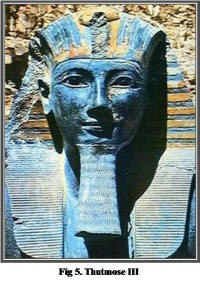 MOSES
CHOICE
MOSES
CHOICE The
Ipuwer Papyrus (fig. 6)
The
Ipuwer Papyrus (fig. 6) The
tenth and final plague was the slaying of Egyptian
firstborn. The eldest male child of every Egyptian
household was killed
The
tenth and final plague was the slaying of Egyptian
firstborn. The eldest male child of every Egyptian
household was killed  1.
Route Through Egypt
1.
Route Through Egypt God intervened to deliver His people with three
distinct miracles:
God intervened to deliver His people with three
distinct miracles: b.
b. -
- The
route of Israel runs south along the Red Sea for over
100 miles and then diagonally inland toward modern Jebel
Musa (Mount Sinai) nearly 50 miles. From this point,
where Israel remained for nearly a year, it leads north
to Kadesh-barnea at the southern end of Canaan.
The
route of Israel runs south along the Red Sea for over
100 miles and then diagonally inland toward modern Jebel
Musa (Mount Sinai) nearly 50 miles. From this point,
where Israel remained for nearly a year, it leads north
to Kadesh-barnea at the southern end of Canaan. The
tabernacle (fig. 14) consisted of a portable building
located within a rectangular court. The court measured
150 feet by 75 feet, and was enclosed by linen curtains
hung from silver hooks on silver-covered rods attached
to posts of acacia wood.
The
tabernacle (fig. 14) consisted of a portable building
located within a rectangular court. The court measured
150 feet by 75 feet, and was enclosed by linen curtains
hung from silver hooks on silver-covered rods attached
to posts of acacia wood. God
directed that the tabernacle be located in the exact
center of the tribes, when encamped during the
wilderness journey. When marching the tabernacle
furniture was to be kept in the center, though the
tabernacle itself was to go earlier so that it might be
erected in time for the furniture to be set in place on
arrival
God
directed that the tabernacle be located in the exact
center of the tribes, when encamped during the
wilderness journey. When marching the tabernacle
furniture was to be kept in the center, though the
tabernacle itself was to go earlier so that it might be
erected in time for the furniture to be set in place on
arrival  3.
Death of Aaron
3.
Death of Aaron
 o
o